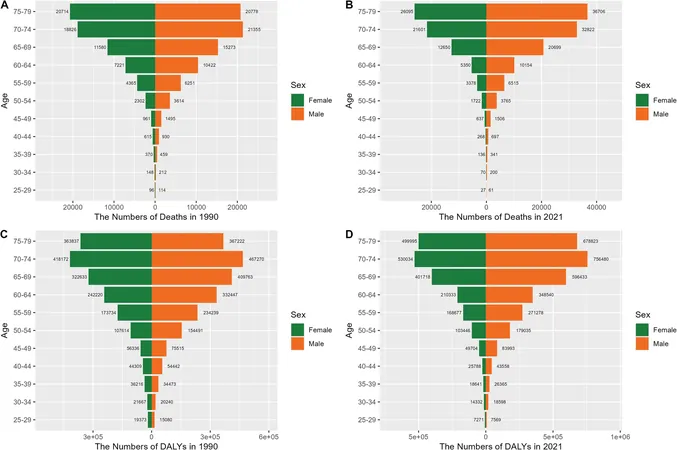
Unveiling the Alarming Impact of Air Pollution on Ischemic Stroke in China: A 30-Year Review
2025-04-28
Author: John Tan
Introduction: A Health Crisis in the Making
As the shadow of air pollution looms larger over China, the link between environmental hazards and health concerns becomes increasingly dire. A recent extensive analysis, leveraging the 2021 Global Burden of Disease (GBD) database, sheds light on the alarming rise of ischemic strokes due to air pollution from 1990 to 2021.
Data Insights: Tracking the Burden
The GBD database provides a goldmine of information, detailing the incidence and mortality rates of diseases such as ischemic stroke across various demographics. This comprehensive dataset, reliable and recognized for its representation of China's population, reveals critical trends in how air pollution exacerbates health outcomes.
Temporal Trends: Unraveling the Numbers
Using a robust Joinpoint regression model, researchers have identified significant changes in the burden of ischemic strokes related to air pollution over the past three decades. From 1990 to 2021, the age-standardized mortality rate (ASMR) declined from 35.84 to 19.50 per 100,000 people, and the age-standardized disability-adjusted life years (ASDR) plummeted from 656.13 to 355.52 per 100,000.
A Closer Look at Age and Gender Dynamics
The findings starkly illustrate that older adults, particularly men aged 70 and above, carry the heaviest burden of these strokes. Notably, males consistently showed higher rates of mortality and disability compared to females in the same age groups.
Drivers of Change: What's Behind the Trends?
Decomposition analysis reveals that while aging and population growth complicate the picture, the primary driver for declining mortality rates is linked to epidemiological changes. Public health initiatives aimed at improving air quality are taking effect, yet challenges persist.
Predicting the Future: A Mixed Bag of Trends
Forecasting trends using the Autoregressive Integrated Moving Average (ARIMA) model suggests a gloomy future for men, where rates of ischemic strokes due to air pollution are projected to rise, contrasting a continued decline for women. By 2036, the ASMR for men could soar to 46.31 per 100,000, while women's rates are expected to fall to 8.26.
Underlying Factors: Gender and Age Disparities
The study highlights stark gender disparities, with men facing a higher risk due to behavioral factors such as increased smoking and outdoor exposure to pollutants. Additionally, biological vulnerabilities further complicate the impact, especially among older populations.
Public Health Recommendations: Time for Action
To combat these escalating rates, tailored public health strategies are imperative, focusing on vulnerable populations like elderly men. Awareness campaigns about the dangers of air pollution must ramp up, alongside initiatives to improve healthcare access for those at risk.
Concluding Thoughts: Urgency in Response
While strides have been made in mitigating air pollution, the fight is far from over. Continuous efforts to raise public awareness and implement rigorous air quality measures are vital to safeguard public health, particularly for the most affected demographics. The road ahead demands vigilance and unyielding commitment to environmental health.



 Brasil (PT)
Brasil (PT)
 Canada (EN)
Canada (EN)
 Chile (ES)
Chile (ES)
 Česko (CS)
Česko (CS)
 대한민국 (KO)
대한민국 (KO)
 España (ES)
España (ES)
 France (FR)
France (FR)
 Hong Kong (EN)
Hong Kong (EN)
 Italia (IT)
Italia (IT)
 日本 (JA)
日本 (JA)
 Magyarország (HU)
Magyarország (HU)
 Norge (NO)
Norge (NO)
 Polska (PL)
Polska (PL)
 Schweiz (DE)
Schweiz (DE)
 Singapore (EN)
Singapore (EN)
 Sverige (SV)
Sverige (SV)
 Suomi (FI)
Suomi (FI)
 Türkiye (TR)
Türkiye (TR)
 الإمارات العربية المتحدة (AR)
الإمارات العربية المتحدة (AR)